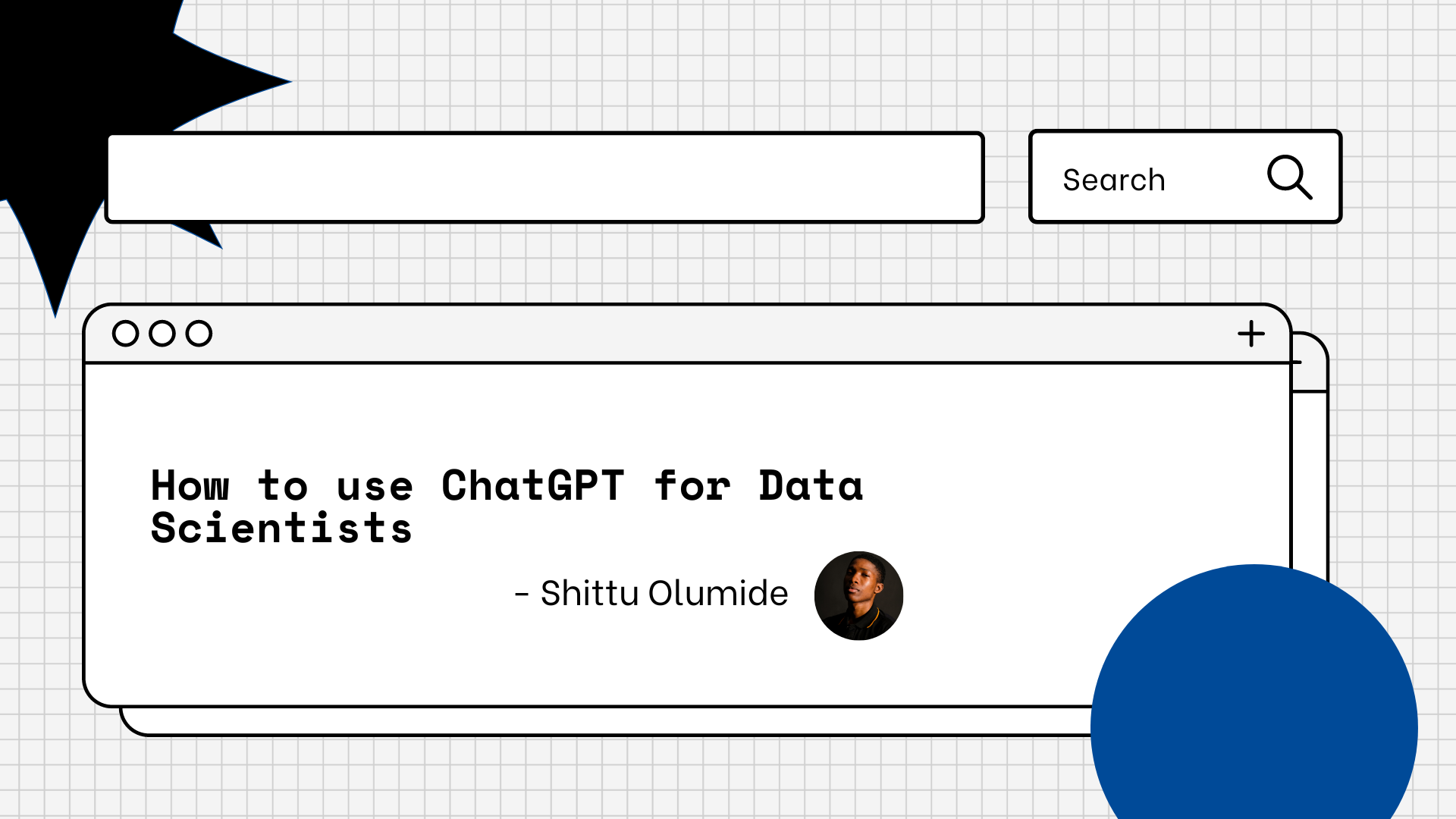These days, many people are concerned with the way AI is evolving. They see it effortlessly solving problems, performing tasks quickly and accurately, and doing jobs easily and efficiently.
And while some people are scared, others are actually embracing it. I'm one of those people who are embracing it, and I advise you to do the same. Learn to use AI to your own advantage.
This isn't a new phenomenon. Back in the day when the internet started out, many people were skeptical about it and didn't want to change. They didn't want to move their businesses online. But the reverse is the case now – almost all businesses nowadays have an online presence.
I believe this is how it's going to be in the very near future: anyone who can't use AI to their benefit and leverage its capabilities may suffer.
To be able to get the best results when using an AI tool, you need to be able to ask the right questions and input the correct prompts.
In this article, I'll share some useful and important prompts that data scientists can use. We'll cover areas such as machine learning, data visualization, and lots more.
What is ChatGPT?
ChatGPT is a language model developed by OpenAI that's based on the GPT-3.5 architecture. It use deep learning algorithms to generate human-like responses to user queries or inputs.
As a language model, it has been trained on a massive amount of textual data from various sources and can understand and generate text in multiple languages.
ChatGPT can do many things, including the following:
- Answering general knowledge questions.
- Providing simpler explanations of complex concepts.
- Generating creative writing prompts.
- Summarizing long passages of text.
- Recommending products or services based on user preferences.
- Translating text into different languages.
- Generating human-like responses to conversations.
- Helping with language learning by providing definitions and examples of words and phrases.
- Generating personalized content, such as emails and social media posts.
- Creating chatbots and virtual assistants for businesses.
- Assisting with research by providing relevant information and sources.
- Generating jokes and humorous responses.
- Assisting with mental health by providing coping strategies and resources.
- Analyzing data and generating reports.
- Generating music and art based on user input and preferences.
Note that this list is not exhaustive. ChatGPT's capabilities are constantly evolving and expanding with advancements in artificial intelligence technology.
Best Practices for Creating Good Prompts
Coming up with good question prompts for ChatGPT can be challenging, but some general principles and strategies can help guide you in the process.
- Clearly define the goal of the question: Before formulating a good question for ChatGPT, it's important to be clear on what you're trying to achieve. What information or insight are you hoping to get from the model? Once you have a clear goal in mind, you can start to think about the types of questions that might be most useful.
- Keep it specific and focused: ChatGPT is good at generating answers to specific questions, so it's important to frame your questions in a specific and focused way. Avoid broad or vague questions, and be as clear and concise as possible.
- Use natural language: ChatGPT is designed to understand and generate natural language, so it's important to use it when formulating your questions. Avoid using technical jargon or complex language that might be difficult for the model to understand.
- Provide context: ChatGPT works best when it has context to work with, so it can be helpful to provide some context when formulating your questions. This might include providing background information or explaining the context of the question.
- Test and refine: Finally, testing your question prompts and refining them over time is important. Try different types of questions and see how ChatGPT responds. Pay attention to the quality and accuracy of the answers you get, and use this feedback to refine your question prompts and improve the quality of the information you get from ChatGPT.
Let's explore some of these areas in data science and highlight the types of questions you can ask ChatGPT to get helpful responses.
Data Exploration
Data Exploration is the process of analyzing, visualizing, and understanding a dataset to discover patterns, trends, and relationships between the variables.
Here are 10 example questions you can ask ChatGPT to get some really helpful answers about data exploration:
- What is data exploration and how is it useful in data science?
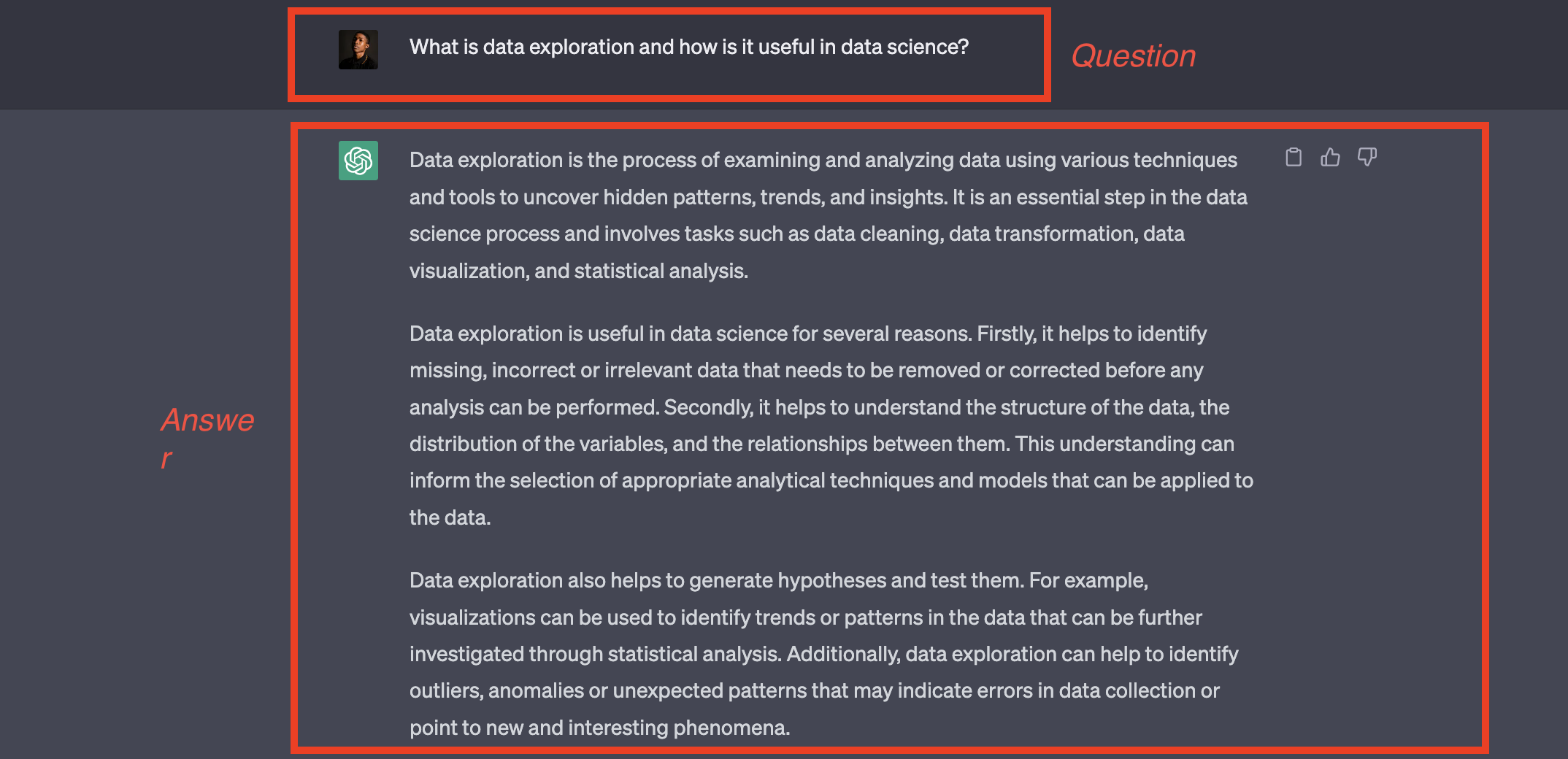
2. What are some popular Python libraries for data exploration and how are they used?
3. Can you provide an example of a basic data exploration script using Python?
4. How can you identify patterns and trends in time series data using Pandas and Matplotlib?
5. How can you generate scatterplots and line charts to explore relationships between variables using Pandas and Matplotlib?
6. How can you perform dimensionality reduction using PCA to explore relationships between variables?
7. Can you provide an example of a data exploration script that identifies patterns and trends in data using Pandas and Seaborn?
8. What are some common techniques for exploring relationships between variables using Pandas and Matplotlib?
9. Can you provide an example of a data exploration script that uses t-SNE, PCA, and clustering to explore relationships between variables?
10. How can you perform dimensionality reduction using PCA to explore relationships between variables?
Data Analysis
Data analysis involves collecting, cleaning, transforming, and modeling data to draw insights and conclusions from it. It is important in many fields such as business, science, engineering, and social sciences.
Here are 10 questions that you can ask ChatGPT to get the most helpful answers about data analysis:
- What is the difference between data analysis and data mining?
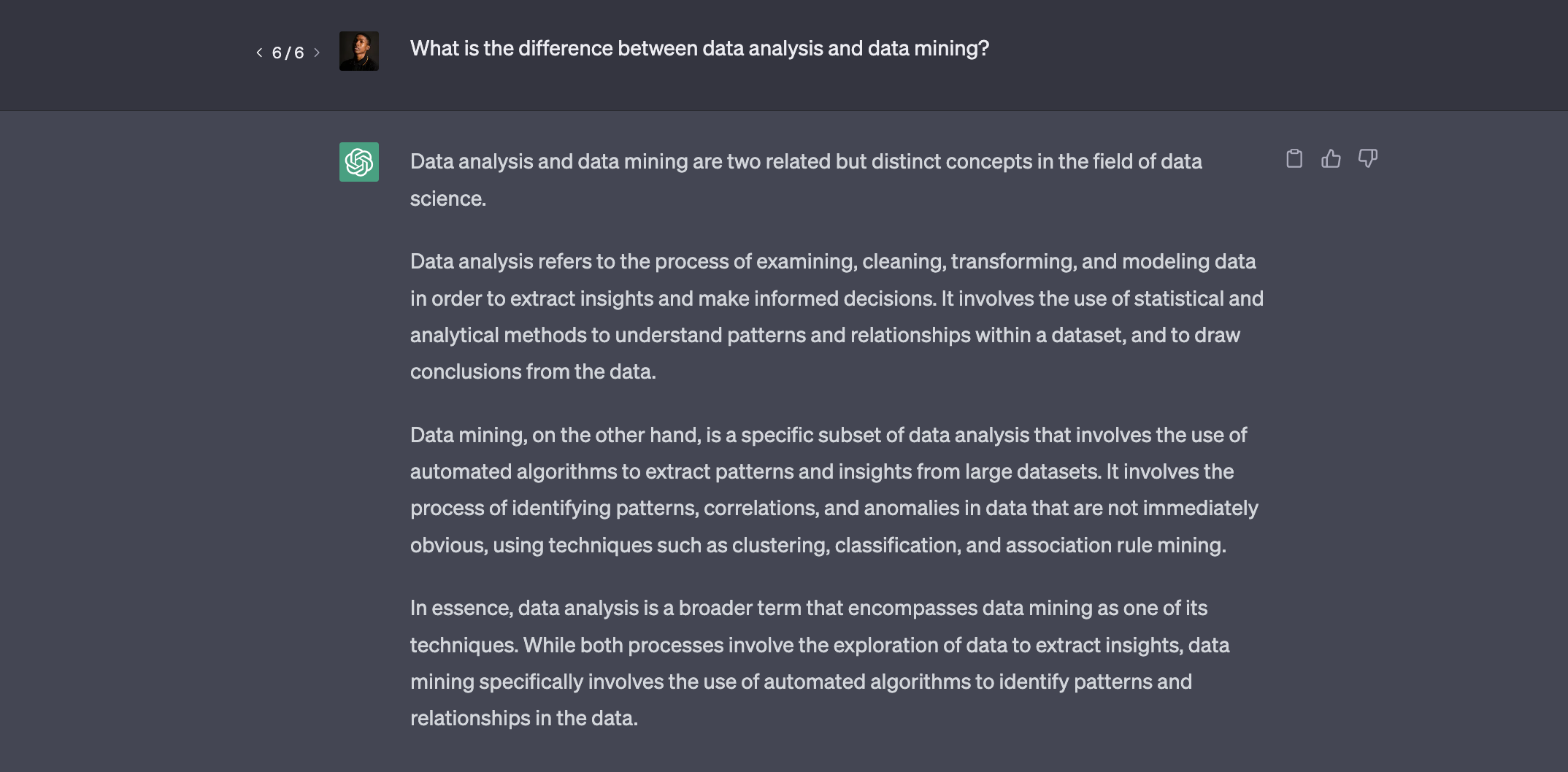
2. What are the most common data analysis methods?
3. What is the difference between descriptive and inferential statistics?
4. How do I select the appropriate statistical test for my data?
5. How can I use data visualization to analyze my data?
6. What are some common challenges in data analysis, and how can I overcome them?
7. What are some techniques for cleaning and preprocessing data?
8. How can I ensure the quality and accuracy of my data?
9. How can I use machine learning algorithms for data analysis?
10. What are some ethical considerations in data analysis, and how can I address them?
Data Visualization
Data visualization refers to representing data and information through graphical or visual means, such as charts, graphs, and maps, to help people understand complex data sets and patterns quickly and efficiently.
Here are 10 possible questions you could ask ChatGPT to learn more about data visualization:
- What are some popular Python libraries for data visualization and how are they used?
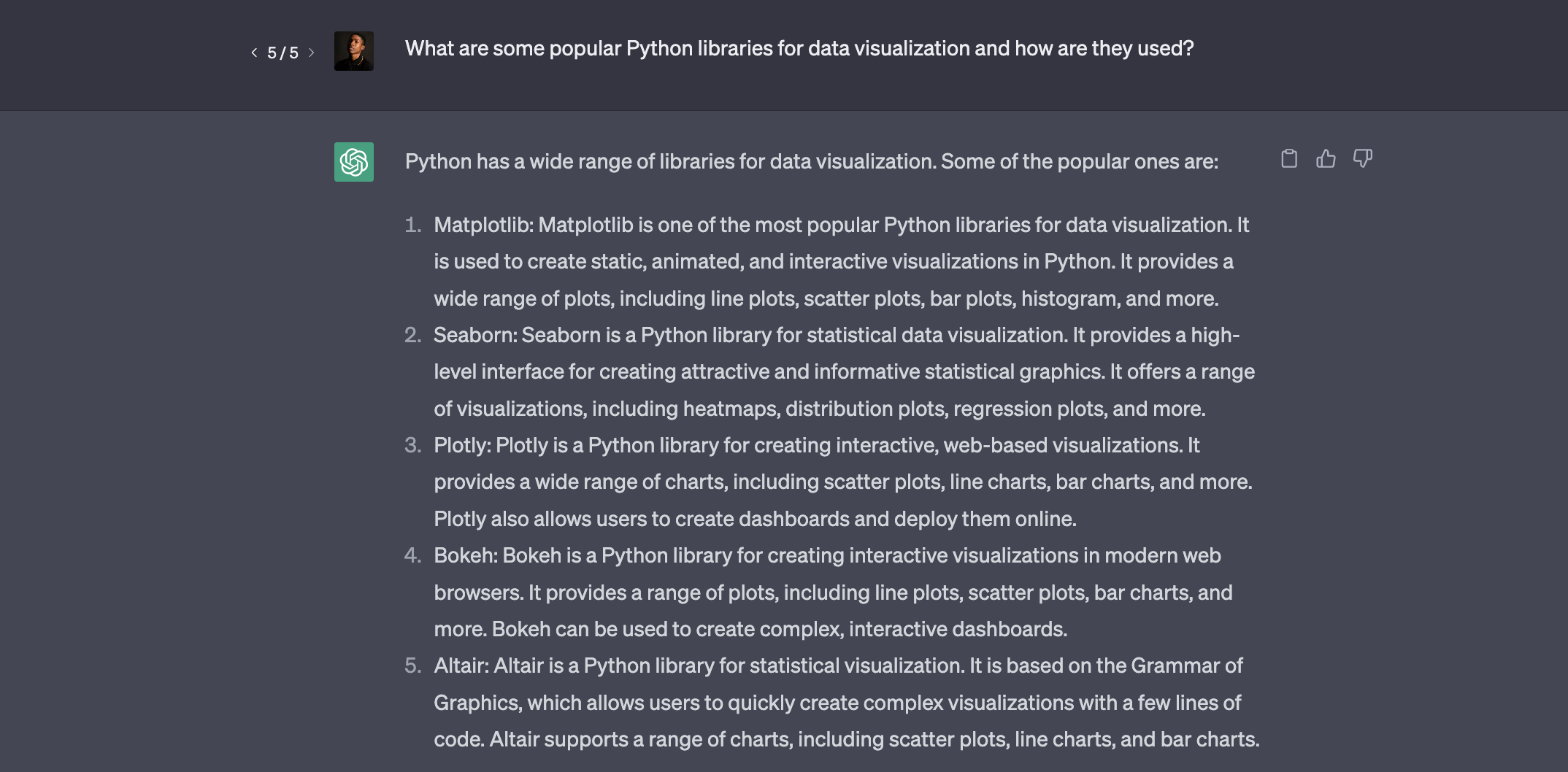
2. Can you give me an example of creating interactive graphs with Plotly?
3. How can you ensure that your visualizations are accessible and readable?
4. How can you choose the right chart or graph for different types of data?
5. Can you provide an example of a basic data visualization script using Python?
6. What are some common techniques for creating static visualizations using Matplotlib and Seaborn?
7. How can you perform correlation analysis and heat mapping using Pandas and Matplotlib?
8. C an you provide an example of a data visualization that adheres to best practices for effective visualization design?
9. How can you create line charts, bar charts, scatterplots, and other visualizations using Matplotlib and Seaborn?
10. What are some examples of innovative data visualizations and how were they created?
Data Mining
Data mining involves discovering patterns and insights from large datasets using statistical and computational methods. It lets you extract useful information from data and transform it into an understandable structure for further use.
Here are 10 questions that you can ask ChatGPT to get the best answers about data mining:
- What is the difference between data mining and machine learning?
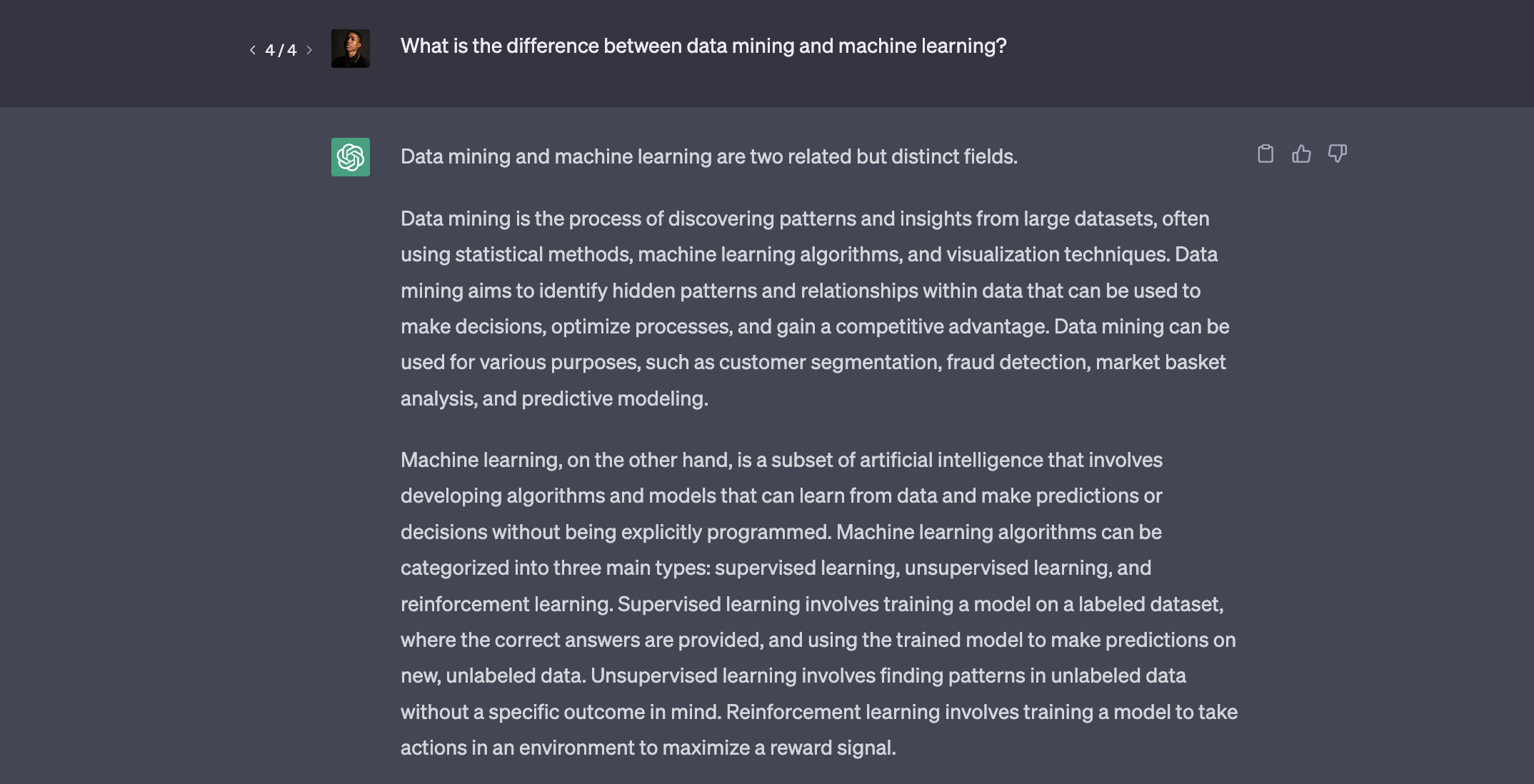
2. What are some standard techniques used in data mining?
3. How does data mining help in decision-making processes?
4. What are some of the benefits of data mining?
5. Can you explain the process of data mining in simple terms?
6. What are some of the challenges of data mining?
7. How can data mining be used in marketing and advertising?
8. Can you provide some examples of successful data mining applications?
9. What ethical considerations should be taken into account when using data mining?
10. How can data mining be used in healthcare and medical research?
Machine Learning
Machine Learning is a branch of artificial intelligence that allows computer systems to learn from data without being explicitly programmed. The primary goal of machine learning is to enable machines to automatically improve their performance on a particular task through experience automatically.
Here are 10 questions that you can ask ChatGPT to learn more about Machine Learning:
- Can you provide an example of a basic machine learning script using Python?
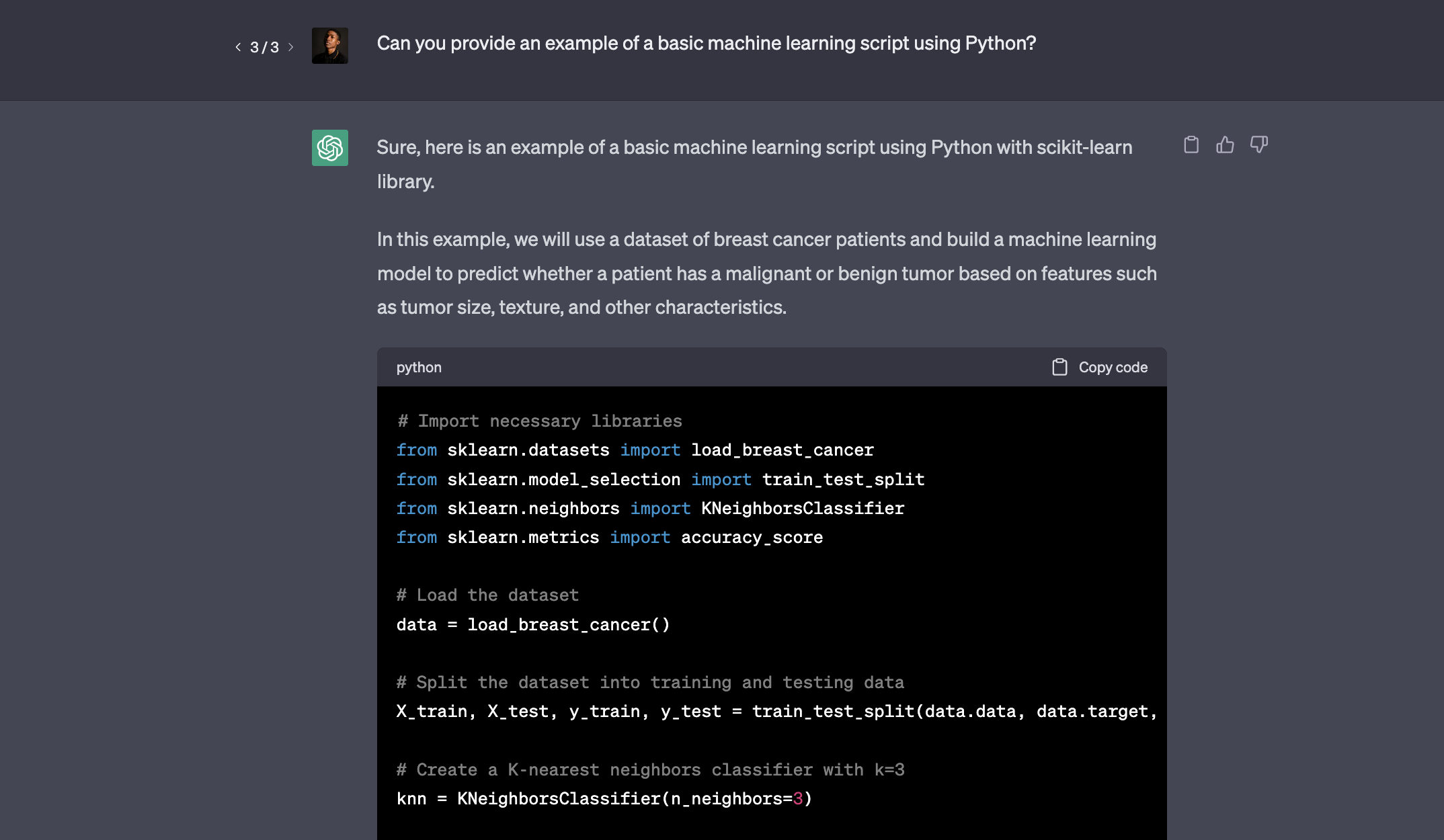
2. What are some popular Python libraries for machine learning and how are they used?
3. What is a model selection and how can you choose the right algorithm for a machine learning problem?
4. How can you compare the performance of different machine learning models using different metrics?
5. Can you write code that will apply 6 different classification algorithms at once, and evaluate them by using precision-recall and f1 score and append the results to the data frame called pred_df?
6. How can you perform clustering and dimensionality reduction tasks using Scikit-Learn?
7. Can you provide an example of a machine learning script that performs model selection using Scikit-Learn?
8. How can you perform regression and classification tasks using Scikit-Learn?
9. What are some best practices for deploying machine learning models in production?
10. How can you evaluate the performance of an unsupervised learning model using different metrics?
More Tips on Interacting with ChatGPT
Once you have your responses from ChatGPT, there's still a lot you can do. ChatGPT has contextual awareness, so it doesn't "forget" what you were talking about if you ask in the same session/thread. Try these techniques to get even more info:
- Ask follow-up questions: If ChatGPT answers your question but you would like more information or clarification, don't hesitate to ask a follow-up question. For example, if you ask, "What is data science?" and ChatGPT responds with a definition, you could follow up with a question like "Can you give me an example of how data science is used in the real world?"
- Ask for clarification: If ChatGPT's response is unclear or you don't understand something, don't hesitate to ask for clarification. ChatGPT is designed to provide clear and concise responses, but sometimes additional explanation may be necessary.
- Be specific: Try to be as specific as possible when asking a question. This will help ChatGPT provide a more accurate and relevant response. For example, instead of asking, "What is the stock market?" you could ask, "How do stock prices fluctuate in response to economic indicators?"
- Use natural language: ChatGPT is designed to understand and respond to natural language, so try to ask questions in a conversational tone. You don't need technical jargon or complex language to get a good response.
- Keep the conversation focused: Stay on topic and avoid asking unrelated or tangential questions. This will help ChatGPT provide more focused and accurate responses. If you want to ask a different question, starting a new conversation is usually best.
Conclusion
ChatGPT is a powerful tool that data scientists can use to enhance their work. With its natural language processing capabilities, ChatGPT can provide quick and accurate answers to a wide range of data mining questions, making it an indispensable resource for those working in this field.
By asking the right questions, you can gain valuable insights into data mining techniques, tools, and best practices, ultimately leading to better decision-making and improved outcomes. Just don't forget to fact-check if you're not super familiar with the topic you're asking about.
With the increasing importance of data mining in today's business world, ChatGPT can help data scientists stay on top of the latest trends and advancements, giving them a competitive edge in the market.
Let's connect on Twitter and on LinkedIn. You can also subscribe to my YouTube channel.
Happy Coding!

